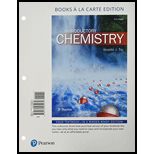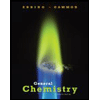
Introductory Chemistry, Books a la Carte Plus Mastering Chemistry with Pearson eText -- Access Card Package (6th Edition)
6th Edition
ISBN: 9780134557311
Author: Nivaldo J. Tro
Publisher: PEARSON
expand_more
expand_more
format_list_bulleted
Question
Chapter 15, Problem 51E
Interpretation Introduction
Interpretation:
The value of equilibrium constant for the given reaction is to be calculated.
COCl2(g)⇌CO(g)+Cl2(g)
Concept introduction:
The equilibrium constant is the ratio of concentrations of products to thoseof reactants each raised to the power of
The equilibrium expression for the above reaction is written as follows:
Keq=[C]c[D]d[A]a[B]b
Here, the reactants are A and B, the products are C and D, and the stoichiometric coefficients are a,b,c, and d.
Expert Solution & Answer
Want to see the full answer?
Check out a sample textbook solution
Students have asked these similar questions
If the ionic strength (I) of a solution is very low, the Debye-Huckel equation is used. If I is higher, the Davies equation is used. What is the correct value for I to use one or the other?
In both the Debye-Huckel equation and the Davies equation, there is a constant A. I see that sometimes it appears as 0.51 and other times as 1.02. Explain why one or the other value is used.
The two equations are forms of the Davies equation, used in thermodynamics for
activity coefficients:
ال
log Y₁ = -Az²
- 0,31
log
= Az²
- 0,31
1 + √Ĩ
1 + √√
k
These equations are consistent and imply that
Yi
=
Is this last equation correct?
k
Chapter 15 Solutions
Introductory Chemistry, Books a la Carte Plus Mastering Chemistry with Pearson eText -- Access Card Package (6th Edition)
Ch. 15 - Q1. Which change is likely to increase the rate of...Ch. 15 - The equilibrium constants at a fixed temperature...Ch. 15 - Q3. The concentrations of A,B, and C for the...Ch. 15 - Q4. What is the correct expression for the...Ch. 15 - Q5. Consider the reaction between NO and to form...Ch. 15 - Q6. The equilibrium constant for this reaction is...Ch. 15 - Prob. 7SAQCh. 15 - Q8. The decomposition of is endothermic.
Which...Ch. 15 - Prob. 9SAQCh. 15 - Prob. 10SAQ
Ch. 15 - Prob. 1ECh. 15 - Prob. 2ECh. 15 - 3. Why do chemists seek to control reaction...Ch. 15 - How do most chemical reactions occur?Ch. 15 - What factors influence reaction rates? How?Ch. 15 - Prob. 6ECh. 15 - 7. What is dynamic chemical equilibrium?
Ch. 15 - Prob. 8ECh. 15 - Explain why the concentrations of reactants and...Ch. 15 - Devise your own analogylike the Narnia and Middle...Ch. 15 - Prob. 11ECh. 15 - Write the expression for the equilibrium constant...Ch. 15 - What does a small equilibrium constant tell you...Ch. 15 - Prob. 14ECh. 15 - Prob. 15ECh. 15 - Prob. 16ECh. 15 - Prob. 17ECh. 15 - Prob. 18ECh. 15 - What is the effect of decreasing the concentration...Ch. 15 - Prob. 20ECh. 15 - Prob. 21ECh. 15 - What is the effect of increasing the pressure of a...Ch. 15 - Prob. 23ECh. 15 - Prob. 24ECh. 15 - 25. What is the effect of decreasing the pressure...Ch. 15 - 26. What is the effect of increasing the...Ch. 15 - 27. What is the effect of increasing the...Ch. 15 - Prob. 28ECh. 15 - Prob. 29ECh. 15 - Prob. 30ECh. 15 - Prob. 31ECh. 15 - Prob. 32ECh. 15 - Prob. 33ECh. 15 - Prob. 34ECh. 15 - Does a catalyst affect the value of the...Ch. 15 - Prob. 36ECh. 15 - Prob. 37ECh. 15 - Prob. 38ECh. 15 - The body temperature of cold-blooded animals...Ch. 15 - The rate of a particular reaction doubles when the...Ch. 15 - Prob. 41ECh. 15 - Prob. 42ECh. 15 - Write an equilibrium expression for each chemical...Ch. 15 - Prob. 44ECh. 15 - Write an equilibrium expression for each chemical...Ch. 15 - Write an equilibrium expression for each chemical...Ch. 15 - Prob. 47ECh. 15 - Prob. 48ECh. 15 - 49. For each equilibrium constant, indicate if you...Ch. 15 - Prob. 50ECh. 15 - Prob. 51ECh. 15 - 52. Consider the reaction.
An equilibrium mixture...Ch. 15 - Consider the reaction. 2H2S(g)2H2(g)+S2(g) An...Ch. 15 - Prob. 54ECh. 15 - Prob. 55ECh. 15 - Consider the reaction. CaCO3(s)CaCO(s)+CO2(g) An...Ch. 15 - Prob. 57ECh. 15 - Prob. 58ECh. 15 - Prob. 59ECh. 15 - Prob. 60ECh. 15 - Prob. 61ECh. 15 - Prob. 62ECh. 15 - Consider this reaction at equilibrium....Ch. 15 - Prob. 64ECh. 15 - Consider this reaction at equilibrium....Ch. 15 - Prob. 66ECh. 15 - Consider the effect of a volume change on this...Ch. 15 - Prob. 68ECh. 15 - Prob. 69ECh. 15 - Prob. 70ECh. 15 - Prob. 71ECh. 15 - Prob. 72ECh. 15 - Prob. 73ECh. 15 - Prob. 74ECh. 15 - Coal, which is primarily carbon, can be converted...Ch. 15 - 76. Coal can be used to generate hydrogen gas (a...Ch. 15 - 77. For each compound, write an equation showing...Ch. 15 - Prob. 78ECh. 15 - Prob. 79ECh. 15 - Prob. 80ECh. 15 - A saturated solution of MgF2 has [Mg2+]=2.6104M...Ch. 15 - Prob. 82ECh. 15 - Prob. 83ECh. 15 - Prob. 84ECh. 15 - Prob. 85ECh. 15 - Prob. 86ECh. 15 - Prob. 87ECh. 15 - 88. Calculate the molar solubility of .
Ch. 15 - Prob. 89ECh. 15 - Prob. 90ECh. 15 - 91. Consider the reaction.
A solution is made...Ch. 15 - Prob. 92ECh. 15 - Prob. 93ECh. 15 - Prob. 94ECh. 15 - This reaction is exothermic....Ch. 15 - Prob. 96ECh. 15 - 97. Calculate the molar solubility of CuS. How...Ch. 15 - Calculate the molar solubility of FeCO3. How many...Ch. 15 - Prob. 99ECh. 15 - Prob. 100ECh. 15 - Prob. 101ECh. 15 - Prob. 102ECh. 15 - Consider the reaction: CaCO3CaO(s)+CO2(g) A sample...Ch. 15 - Prob. 104ECh. 15 - A 2.55-L solution is 0.115 M in Mg2+. If K2CO3 is...Ch. 15 - Prob. 106ECh. 15 - Prob. 107ECh. 15 - Prob. 108ECh. 15 - One of the main components of hard water is CaCO3....Ch. 15 - Prob. 110ECh. 15 - The reaction A(g)+B(g)2C(g) has an equilibrium...Ch. 15 - Describe three ways a reaction at equilibrium can...Ch. 15 - Solid CaCO3 decomposes into solid CaO and gaseous...
Knowledge Booster
Learn more about
Need a deep-dive on the concept behind this application? Look no further. Learn more about this topic, chemistry and related others by exploring similar questions and additional content below.Similar questions
- The two equations are forms of the Davies equation, used in thermodynamics for activity coefficients: ال log Y₁ = -Az² - 0,31 log = Az² - 0,31 1 + √Ĩ 1 + √√ k These equations are consistent and imply that Yi = Is this last equation correct? karrow_forwardFor the Davies equation, both expressions are correct: log Y₁ = -Az² √i - 0,31 1 + √ k log- = Az - 0,31 k 1 + √Ĩarrow_forwardk In Davies' equation log y₁ = log- log y₁ = log | = -Az² + ✓// k A is a constant that always equals 1.02. Correct? - 0,31arrow_forward
- Indicate whether the equality is true Yi How is it obtained? k%arrow_forwardIndicate the relationship between the activity coefficient YA and the rate constant of a bimolecular reaction in solution k and the rate constant at infinite dilution ko.arrow_forwardDescribe the saline effect that occurs in solutions.arrow_forward
- Briefly explain what the infinite dilution rate constant (k∞) consists of.arrow_forwardThe Davies equation corrects the Debye-Hückel limiting law for calculating the activity coefficient of an electrolyte in solution at relatively high concentrations. Mathematically, it is expressed as: log y₁ = -Az²? 1 + √Ĩ - 0,31) Is the formula correct?arrow_forwardDifferentiate between the concepts of "ionic salt effect" and "kinetic salt effect."arrow_forward
- Differentiate the concepts of “salino effect” and “salino kinetic effect”.arrow_forwardCome and compare the Bronsted-Bjerrum calculation, the Debye and Hückel calculation, and the Davies calculation.arrow_forwardplz watch the youtube video (the title of this topic) by roxi H. she explains it step by step but i get the wrong answerarrow_forward
arrow_back_ios
SEE MORE QUESTIONS
arrow_forward_ios
Recommended textbooks for you
 Chemistry: The Molecular ScienceChemistryISBN:9781285199047Author:John W. Moore, Conrad L. StanitskiPublisher:Cengage Learning
Chemistry: The Molecular ScienceChemistryISBN:9781285199047Author:John W. Moore, Conrad L. StanitskiPublisher:Cengage Learning Chemistry & Chemical ReactivityChemistryISBN:9781337399074Author:John C. Kotz, Paul M. Treichel, John Townsend, David TreichelPublisher:Cengage Learning
Chemistry & Chemical ReactivityChemistryISBN:9781337399074Author:John C. Kotz, Paul M. Treichel, John Townsend, David TreichelPublisher:Cengage Learning Chemistry & Chemical ReactivityChemistryISBN:9781133949640Author:John C. Kotz, Paul M. Treichel, John Townsend, David TreichelPublisher:Cengage Learning
Chemistry & Chemical ReactivityChemistryISBN:9781133949640Author:John C. Kotz, Paul M. Treichel, John Townsend, David TreichelPublisher:Cengage Learning Chemistry for Engineering StudentsChemistryISBN:9781337398909Author:Lawrence S. Brown, Tom HolmePublisher:Cengage Learning
Chemistry for Engineering StudentsChemistryISBN:9781337398909Author:Lawrence S. Brown, Tom HolmePublisher:Cengage Learning General Chemistry - Standalone book (MindTap Cour...ChemistryISBN:9781305580343Author:Steven D. Gammon, Ebbing, Darrell Ebbing, Steven D., Darrell; Gammon, Darrell Ebbing; Steven D. Gammon, Darrell D.; Gammon, Ebbing; Steven D. Gammon; DarrellPublisher:Cengage Learning
General Chemistry - Standalone book (MindTap Cour...ChemistryISBN:9781305580343Author:Steven D. Gammon, Ebbing, Darrell Ebbing, Steven D., Darrell; Gammon, Darrell Ebbing; Steven D. Gammon, Darrell D.; Gammon, Ebbing; Steven D. Gammon; DarrellPublisher:Cengage Learning Chemistry: Principles and PracticeChemistryISBN:9780534420123Author:Daniel L. Reger, Scott R. Goode, David W. Ball, Edward MercerPublisher:Cengage Learning
Chemistry: Principles and PracticeChemistryISBN:9780534420123Author:Daniel L. Reger, Scott R. Goode, David W. Ball, Edward MercerPublisher:Cengage Learning

Chemistry: The Molecular Science
Chemistry
ISBN:9781285199047
Author:John W. Moore, Conrad L. Stanitski
Publisher:Cengage Learning

Chemistry & Chemical Reactivity
Chemistry
ISBN:9781337399074
Author:John C. Kotz, Paul M. Treichel, John Townsend, David Treichel
Publisher:Cengage Learning

Chemistry & Chemical Reactivity
Chemistry
ISBN:9781133949640
Author:John C. Kotz, Paul M. Treichel, John Townsend, David Treichel
Publisher:Cengage Learning

Chemistry for Engineering Students
Chemistry
ISBN:9781337398909
Author:Lawrence S. Brown, Tom Holme
Publisher:Cengage Learning

General Chemistry - Standalone book (MindTap Cour...
Chemistry
ISBN:9781305580343
Author:Steven D. Gammon, Ebbing, Darrell Ebbing, Steven D., Darrell; Gammon, Darrell Ebbing; Steven D. Gammon, Darrell D.; Gammon, Ebbing; Steven D. Gammon; Darrell
Publisher:Cengage Learning

Chemistry: Principles and Practice
Chemistry
ISBN:9780534420123
Author:Daniel L. Reger, Scott R. Goode, David W. Ball, Edward Mercer
Publisher:Cengage Learning
Chemical Equilibria and Reaction Quotients; Author: Professor Dave Explains;https://www.youtube.com/watch?v=1GiZzCzmO5Q;License: Standard YouTube License, CC-BY